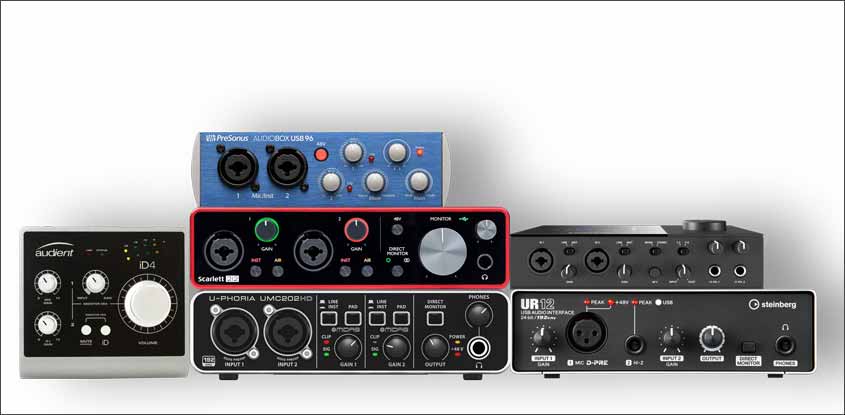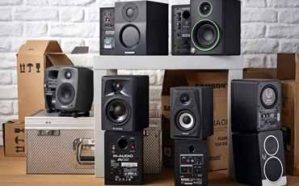Why An Audio Interface? Why not the built-in computer sound card?
In fact, every built-in computer sound card can be considered as an audio interface. But they are not specifically designed for recording high quality audio and offers very limited input & output options. In-built computer sound cards typically offer only a stereo input, a mic input and a headphone output. If you ever have to record 2 or more instruments at the same time, you are out of luck! Also, the components and signal paths are prone to electromagnetic and radio interferences, audio jitter & unacceptable latency. All these factors will render your recordings sub quality.
But a dedicated audio interface is built to withstand and overcome these shortcomings and the quality of the pre amps and A/D-D/A converters are pristine. The entire signal path is also balanced, means your sound is totally noise free. Some models with top quality components, converters, pre amps etc. will have higher price tags.
Select the best possible Inputs/Output (I/O) option that suits you
Before choosing on your interface, be aware of your immediate and future needs. Audio interfaces comes with a lot of I/O options, ranging from a single input to many. So, if you are just a karaoke singer with no plans of recording an instrument in future, a single input interface would be sufficient. If you are a singer/songwriter, perhaps a 2 input model can serve you well. But for a drummer or a whole band who require 8,12,16 or 24 simultaneous inputs, your best bet is to go for models with a higher input count. Also keep in mind about your expansion plans. Later, you might think of opening a commercial project studio for others.
Also check that the input connections on your audio interface are just sufficient enough for you. Most interfaces have XLR inputs (for mics), TRS/TS Jack input (for instruments) or XLR/TRS Combi (for mics and instruments). Count and verify that you are buying what you require. For example, if you only have one XLR and one TRS on your interface, you will not be able to connect 2 mics at the same time. For that you need two XLRs or two XLR/TRS Combis.
Look for the key product specifications
The overall quality of any audio interface is based on a few important specifications. Make sure that you are meticulously checking them to ensure that they meet the present-day industry standards. Lets see a few of the most important technical aspects that one should be looking for.
BIT DEPTH: While your interface is converting your analog signal to digital data, it is basically converting into bits and bytes. A higher bit depth number normally ensures a better representation of your sound in digital form. The CD format normally requires a bit depth of only 16-bit, but has elevated noise levels that are more apparent where the music is softer.
The pro-audio standard for bit depth today is 24-bit. It also removes most of the noise floor and offer plenty of headroom for very dynamic performers like vocalists, guitarists, bassists, drummers etc. So, we strongly suggest you to go with an interface having 24-bit bit depth and your recordings will certainly sound more pro grade.
SAMPLE RATE: Sample rate is expressed in Kilo Hertz and often abbreviated as kHz. Sample rate can be simplified as ‘the number of digital snapshots your audio interface captures of your sound per each second’. For example, an interface with a sample rate of 44.1kHz will take 44,100 pictures of any incoming audio signal. At this sample rate, one can record sound frequencies up to 22.05kHz and is certainly well above what human ears can hear. CD audio have a sample rate of 44.1kHz, but most modern day audio interfaces can go higher like 48kHz, 96kHz, or up to 192kHz. Higher sampling rates can yield a more substantial quality to your recordings.
Most pro level engineers go for 96kHz or higher, but todays minimum standard for audio-visual industry is 48kHz. So, you better move along with the flow and go for a minimum sample rate of 48kHz. This will be very useful, if you are planning to collaborate with other musicians and studios in future.
We also recommend you to steer clear of anything that gives you a sample rate of only 44.1kHz.
PRE AMP QUALITY: The pre amplifiers (pre amps) on your audio interface is normally placed after your microphone inputs and it does primarily boost the signals from your microphones to required recording levels. The quality of the pre-amp is a major decisive factor on the overall quality of your recordings. Many of the modern day audio interfaces employ well reputed pre amps in their units. Unison (from Universal Audio), Scarlett (from Focusrite), Octane (from M-Audio), XMAX (from Presonus), Yamaha D-PRE (from Steinberg), Midas (from Behringer) etc. are well known for their great pristine sound. Any product with a very generic preamp should be better avoided.
A/D-D/A CONVERTER QUALITY: Just like mentioned earlier, the A/D-D/A converter is the critical heart of your audio interface. The quality and accuracy of the converter in your interface is as important as the bit depth, sampling rate and pre amp quality. Going for well-known brands may also ensure that you get quality converters inside.
Check the connectivity methods to your computer
There are various connectivity options available among modern day audio interfaces. They are USB, Thunderbolt, FireWire, and PCIe (PCI Express). Most PC and Mac computers now come with USB ports (either USB 2 or USB 3). FireWire (either 400 or 800) is generally for Macs. Both of these connections have similar average speeds of about 480Mbps and are sufficiently fast enough.
FireWire is more reliable than USB but there are very few interfaces that use Firewire. The benefit of USB is that a lot of interfaces are designed to run on just USB power without the need for an an external power source. This is a blessing if you are looking for portable recording set-up on your laptop.
On the contrary, Thunderbolt 3 is much faster as 40 Gbps but is currently available only on high end models and comes at a price. PCIe cards are internal cards which are installed on the motherboard of your computer and is the fastest among the lot. They are costlier than FireWire and USB interfaces but there are a few affordable ones too.
So, before you buy, make sure that your computer has the same option for the connectivity method of your audio interface.
Check for the operating system compatibility.
Remember that some audio interfaces are Mac only, some are PC only and some work on both. So, buy one that works on your particular computer. You can always ask and confirm this with our expert sales team at Musicians Corner.



